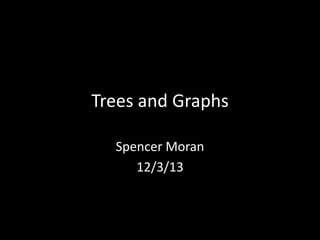Treesandgraphs
- 1. Trees and Graphs Spencer Moran 12/3/13
- 2. Properties of a Tree âĒ Tree is a graph where: â n-1 edges â Connected â No cycles âĒ If two of the above are true, then all 3 are true. âĒ Tree questions are usually asked to test your understanding of recursion.
- 3. Binary Search Trees âĒ Binary tree is one where each node as at most 2 children. âĒ Binary Search tree is a binary tree where all the descendants to the left of a node are smaller than it and all the descendants to the right are greater than it. âĒ Most interview questions focus on binary or binary search trees.
- 4. Binary Search Tree Complexity âĒ âĒ âĒ âĒ âĒ âĒ Lookup: O(log n) Insertion: O(log n) Deletion: O(log n) Smallest/Largest element: O(n) Traversal: O(n) Print in sorted order: O(n)
- 5. Heaps âĒ (Usually) binary tree where each nodeâs children are smaller (or larger in a Min-heap) than it. âĒ Allows for constant time extraction of the largest element in the tree. âĒ Lookup becomes O(n) âĒ Used if extracting the smallest or largest node is paramount
- 6. Searching BFS âĒ Queue âĒ Searches minimum depths first, always searches lowest depth last âĒ High memory requirement âĒ Shortest path DFS âĒ Stack âĒ Explores full depth, doesnât search any particular depth last âĒ Low memory requirement
- 7. Traversals âĒ Pre-order: â Explore node, then left children, then right âĒ In-order: â Explore left children, then node, then right âĒ Post-order: â Explore left children, then right, then node âĒ Implemented using simple recursion
- 9. Sample Question Find the height of a binary tree.
- 10. Strategy âĒ Use recursion âĒ Think of each child as its own separate subtree with that node as the root âĒ Return 1 + the max of left subtreeâs height and right subtreeâs height
- 12. Sample Question Given the value of two nodes in a BST, find the lowest common ancestor. You may assume both values exist in the tree.
- 13. Strategy âĒ Uses the left/right descendant property of a BST to traverse through the nodes. âĒ Starting at the root, traverse through the tree. âĒ If both values are greater than the current node, go right. âĒ If both are smaller than the current, go left. âĒ LCA will be the first node you encounter that is between the two nodes you are given.
- 15. Other Common Tree Questions âĒ Binary tree to heap âĒ Is Binary tree a BST? âĒ Balance an unbalanced BST (left or right rotation) âĒ Count # of leaves
- 16. Graphs âĒ Graph questions are much more complicated and less common. âĒ We will cover graphs during the group meeting.
















